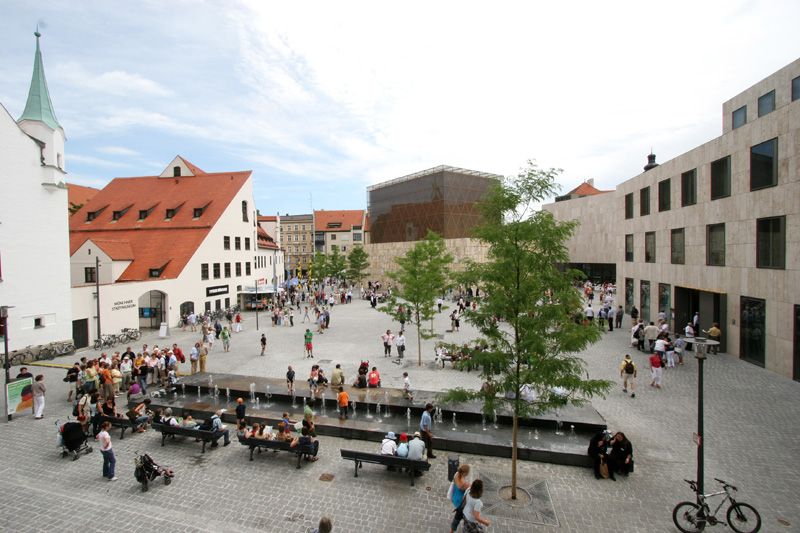Quellen
Bauer, Richard/Brenner, Michael (Hg.): Jüdisches München. Vom Mittelalter bis zur Gegenwart, München 2006.
Israelitische Kultusgemeinde München und Oberbayern (Hg.): Das Neue Jüdische Zentrum, München 2006.
Admission free
Die neue Synagoge samt Gemeindezentrum wurden 2006 im Herzen der Stadt eröffnet

Jakobsplatz mit Synagoge (Bildmitte) und Jüdischem Museum sowie dem Jüdischem Gemeindehaus (rechts), 2008 | Michael Nagy/Presse- und Informationsamt München
Symptomatisch für das Gemeindeleben der Israelitischen Kultusgemeinde München nach 1945 war ihre buchstäbliche „Unbehaustheit“: Schließlich war es nicht selbstverständlich, dass Juden*Jüdinnen in Deutschland und gar in München, der früheren „Hauptstadt der Bewegung“, wieder ansässig werden, Familien gründen und eine Heimat finden konnten und wollten. Den meisten Holocaust-Überlebenden schien solches undenkbar. Jahrzehntelang wurde die eher versteckt gelegene Synagoge in der Reichenbachstraße durch die kleine jüdische Gemeinde genutzt, deren Mitglieder Deutschland häufig nur als Durchgangsstation empfanden.
Schon während des Kalten Krieges waren Juden aus der Tschechoslowakei und aus Polen nach München gekommen, auch aus Israel und Amerika remigrierte Juden stießen zur Gemeinde. Doch vor allem der Zusammenbruch der Sowjetunion und die Wiedervereinigung Deutschlands stellten für die Israelitische Kultusgemeinde eine wichtige Zäsur dar: Seit 1989/90 kamen viele Neuzuwanderer u.a. aus der früheren Sowjetunion zur Israelitischen Kultusgemeinde München, die heute mit etwa 9.500 Mitgliedern die zweitgrößte jüdische Gemeinde Deutschlands ist. Nicht zuletzt diesem Wachstum musste Rechnung getragen werden.
2003 legte die Israelitische Kultusgemeinde München und Oberbayern unter ihrer Präsidentin Charlotte Knobloch den Grundstein für das neue Jüdische Zentrum, am 9.11.2006 wurde die neue Münchner Hauptsynagoge feierlich eröffnet. Die Architektur der Saarbrücker Architektengemeinschaft Wandel Hoefer Lorch (Andrea Wandel, Dr. Rena Wandel-Hoefer, Andreas Hoefer, Prof. Wolfgang Lorch, Hubertus Wandel) greift die Formensprache von Zelt und Tempel, den Aufenthaltsstätten Gottes in der Antike, auf. Der Name Ohel Jakob („Zelt Jakobs“) knüpft aber auch an die Bezeichnung der alten, 1938 zerstörten orthodoxen Synagoge an. Die Errichtung einer neuen Synagoge und eines durch einen Gang mit ihr verbundenen Gemeindezentrums am Jakobsplatz im Herzen der Stadt München symbolisiert die Integration und Selbstverständlichkeit jüdischen Lebens in der deutschen Gesellschaft. Die NS-Vergangenheit und der Holocaust sind in der Erinnerung stets präsent, doch dominieren sie nicht Gegenwart und Zukunft des jüdischen Gemeindelebens.
Bauer, Richard/Brenner, Michael (Hg.): Jüdisches München. Vom Mittelalter bis zur Gegenwart, München 2006.
Israelitische Kultusgemeinde München und Oberbayern (Hg.): Das Neue Jüdische Zentrum, München 2006.